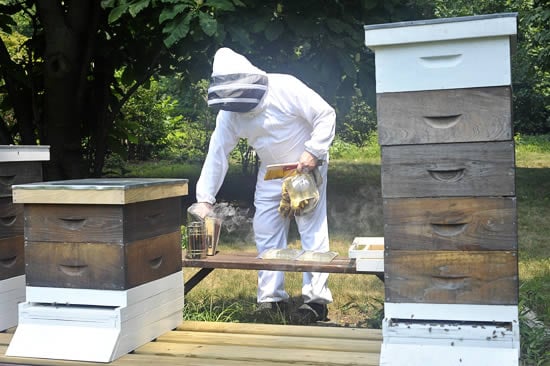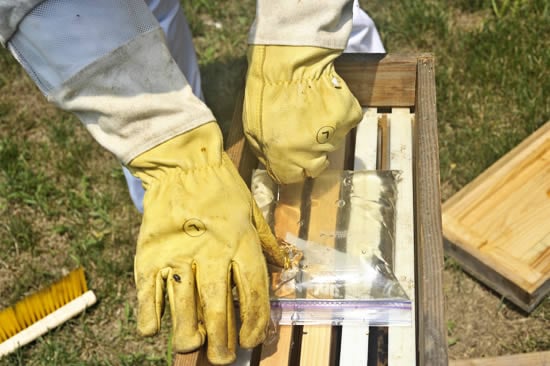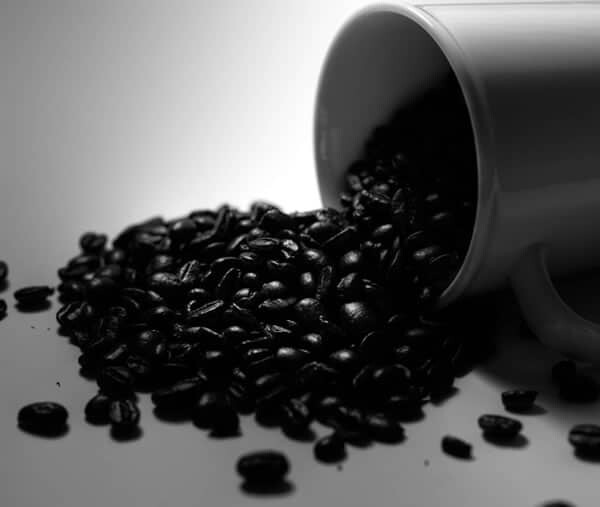Honey Bee Healthy
Oct 20, 2011, Updated Mar 07, 2016

My father has been a bee keeper for quite a few years now so I suppose you could say that I’ve learned through osmosis and by being his assistant from time to time.
He dotes on his bees like they are his children, and I have to say there’s nothing else like the honey that they produce. I grew up on the same land that my great-grandfather lived on. He named his place Tulipwood, which is fitting because the Tulip Tree blossom is the only place that a honeybee can go and completely fill up on nectar without having to go to another source before returning to the hive.
One of the things my dad does to help his hives along is to make them H-B-H, which stands for “Honey Bee Healthy.” He makes his own, but you can buy it too. It includes sugar, water, lecithin granules, spearmint water, and lemongrass oil. He feeds this to them once the honey flow has stopped.
The honey flow stops when the flowers stop blooming, sometime in the middle of the summer. In the fall you start to get more blooms and that’s called the “second flow.”
Last year he lost two hives to starvation, so this year he wanted to get a jump-start and make sure they have plenty of store for the winter so they don’t starve.
He takes a quart bag and adds the liquid after he squeezes most of the air out.
Then he dons his bee suit.
He has Russian bees that come from Don “the Fat Beeman” Kuchenmeister, in Lula, Georgia.
They appear to be more gentle than the Italian bees he used to have. And they’re small cell bees. The small cell bee theory is totally and utterly fascinating, and something I spent a lot of time researching for Food Heroes. I went to Norway and followed a bee keeper around who believes he knows how to “save the bees.”
You see, the bees have been disappearing in recent years in an epidemic called “Colony Collapse Disorder,” and there are many theories as to why. My Norwegian bee friend has the answer, which has made him unpopular among the scientists. (It is a very complicated subject — I wrote a whole chapter on this in the book).
This is the top of the baby hive, called a “nuc.” A small hive helps the new bees get started when you take frames from another hive and let some of them start over.
It’s called a “walkaway split.” You put a frame or two of capped brood, a frame of honey and a frame of pollen, and they make their own queen, and in six weeks they’re back up to speed. To start their own queen, they make royal jelly, and feed it to a regular bee to turn her into a queen.
He lays the plastic bag over the top, lays it over the frames, cuts four small slits in it, and they come up, gather it and take it down to store it.
The smoke makes them drowsy so that you can mess with their hives for a few minutes. When they smell smoke they cluster together down below to protect the queen.
These boxes are made out of cypress wood because, my dad says, “I’m a nut.”
He sands them and oils them and they last forever. “I have happy boxes,” he says.
This year he also produced “comb honey,” where you put boxes in called “shallows.” They are special frames where you can cut a square chunk of honey comb out dripping with honey. So people can “harvest” their own at home, so to speak. I for one love a square of honey comb sitting on a cheese plate. There’s something fun about chewing the wax.
Here he’s pulling out some of the frames to check on them, since two of these hives are brand new.
One isn’t doing as well as the other. The queen isn’t as strong. If she doesn’t lay eggs in a dense pattern, or if she lays eggs more haphazardly, then you don’t get as many bees. And the more bees, the more honey.
Some of the frames have capped brood, which means they have new bees in there percolating. You put a separator in the hive so the queen, who is bigger, can’t fit through to go up high. That way you know you’ll harvest your honey from the top frames, and leave the bottom frames for her to lay eggs in.
Both of these new hives get “HBH.”
But these guys are doing awfully well. They don’t get any extra help. If they do too well, there will be so much honey that they will swarm and start a new hive on a tree somewhere, away from this hive. And that isn’t good. So you have to keep an eye on them and keep adding layers for them to grow into.
Here is the recipe for Honey Bee Healthy that my dad uses. You can make gallons for the price of a store-bought bottle of HBH!
“Honey Bee Healthy”
5 cups Water
2 1/2 pounds Sugar
1/8 tsp. Lecithin Granules (used as an emulsifier)
15 drops Spearmint Oil
15 drops Lemongrass Oil
1. Bring the water to a boil and integrate the sugar until dissolved.
2. Once the sugar is dissolved remove the mixture from the heat and quickly add the lecithin and the essential oils.
3. Stir until everything is evenly distributed. This solution should have a strong scent and not be left open around bees. Cool before using.
Makes 2 quarts.
—
[A note from Andrew: Lecithin doesn’t pass the kitchen test, but since this is for the bees to eat and not us, I figure it’s okay to include this recipe. If you keep bees, or are thinking about keeping bees, I hope the HBH recipe is helpful for you — and your bees!]

































Thanks so much for sharing the recipe, great fit for what I am looking for. I also thoroughly enjoyed your ‘write up’. Although I have been a beekeeper for some time and familiar with your dad’s process, I did find it very interesting that he has obtained some bees from Don. Such a small world.
Chris
hailing from NC
Great article. However, a split will not work with two frames of capped brood. Workers need a frame of eggs and newly hatched eggs to make a new queen. So one of each ( capped and open) will work well with a good number of workers shaken in from the original hive.
Here in the Eastern cape of South Africa some feeding for a long dry winter is highly recommended.
You mention “oil” is that essential oils or tinctures of spearmint and lemongrass? I guess what I am asking is Are they infused or essential oils?
A great article! I would love to spend a few days learning from your dad 🙂 For the HBH, are the spearmint and lemongrass oils “essential” oils or infused oils?
I’ve been using this recipe for my bees. I’ve found that the lecithin can be very difficult dissolve. Both times I’ve made it I’ve ending up fishing out a few undissolved granules. Maybe using liquid lecithin, or powdering the granules first would make this easier? I’m going to experiment a bit.
My bees thank you for sharing this recipe!
Meg, place the mixture in a blender and mix all of it together for approximately 5 to 7 minutes.
Hi, I was wondering, how much of this do you use? Do you use it straight?
thanks
Jennifer
“He lays the plastic bag over the top, lays it over the frames, cuts four small slits in it, and they come up, gather it and take it down to store it.”
So you use it at “full strength.”
Thanks for this, I for one when I get bees again will be planting plenty of mint and lemon balm all around the hives. Those also will be helpful again those mites that bother the bees.
Hello from a backyard beekeeper in Iowa. http://groups.yahoo.com/group/DMBackyardBeekeepers/
I started following your blog this month. Thank you for including honeybees.
Good choice on the cedar! I don’t think he’s a nut for wanting to do things as natural as possible. I was always concerned about using painted boxes for my bees, and how the paint and chemicals may affect them.
FYI, the smoke doesn’t make them drowsy, it makes them afraid that there is a fire so they all huddle around their honey, sucking it up for fear that their home is going to burn down. They see smoke and they gorge themselves on the honey. If you smoke your bees too much and too often, you run the risk of losing a lot of honey that would keep them through winter.
Can’t wait to read what this Norwegian fellow has to say!
All the best,
-J Parris
Great post, thanks!